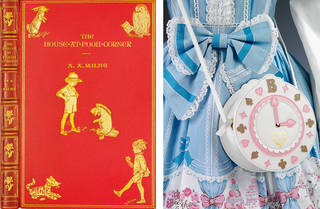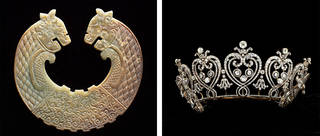Use objects from around the home to help you create your own story. Then design the costumes and sets, and bring it to life! Take a look at the objects in our collections for more inspiration. Designed for ages 7 and up.
Make a treasure hunt story
Choose five everyday things from around your house, such as a small toy, a drawing or photo, something from your school bag, or you could ask a parent or carer to lend you something. Put all your found treasures into a big bag. This is your treasure bag.
Now, let's invent our story. You can write it down, draw some pictures or make it up in your imagination.
First, let's decide who should be the main character of your story – maybe a pirate, spy, a dog, a zombie or whomever you like. Who are they? What do they look like? Use your imagination to think about this character and how they act.

When and where does your story take place? This is called the setting. Does it take place in the past? Today? In the future? Is it in a city? A castle? On a ship? On another planet? The setting could be somewhere specific, like Ancient Egypt or in your house 100 years in the future. Or it could even be in a completely new, imaginary place.

What happens in your story? Think of a beginning, middle and end.
We are going to send your character on a journey to find treasure. Take your treasure bag from earlier, and use it to help you come up with different parts of the story. As you think about your story, reach into your treasure bag, and pull out an object without looking. How can you incorporate this into your story?
You can turn the objects into different things, like a clock changing into a time machine or a book that now has magical powers. Keep pulling out things from your treasure bag until it is empty.

How have these objects helped (or delayed) your main character on their journey? Is there a baddie in your story that is also looking for the treasure?
How does your story end? Did your main character find their treasure? Who did they meet along the way? Where did they go on their journey?
There are over one million objects in the V&A collections that you could also use as inspiration. Here are some examples to get you started.
The double-headed dragon from China was made of jade in the 1600s. Who do you think would carry something like this? Does your character carry something that is special to them?
The tiara is made up of over 1,000 diamonds. Could someone in your story wear a crown like this or another special hat? What would wearing something like this tell other people?

Design your character's costume!
Think about your favourite character in the story. What kind of clothes do you imagine them wearing? What colours? What kind of materials? Did they have a special tool or object to help them?
Draw a picture of your character and think about what costumes and tools they need on their adventure.
This costume was designed to be worn by a fairy with magical powers in a play called The Wooden Prince. It shows a very powerful character. The headpiece and capes are bright colours, and the chest piece was made to look like armour.

Design a set!
Where does your story take place? At sea? On the moon? In a castle? Let's make the place that your story happens.
Find a box in your recycling, a shoe box, a cereal box, small or big. Turn the box sideways and cut out the front to make a mini theatre stage.
Use paper, pens, parts of magazines and newspapers to make your set.
This model of a set was made in 1785 for a play in London. It is supposed to look like Kensington Gardens, a park in central London. Can you see how the actors can come on the stage through the trees on the sides?

Perform your story!
Now, let's bring your story to life. You can read your story or act it out.
Think about the voices that your characters have. Dress up as your character using your own clothes to make a costume. Be inventive!
You could wear something inside out or upside down to make it look different. Use materials, like sheets or blankets to set the scene.
Grab the objects in your story bag and get your family to join in, by making sound effects or being different characters in the adventure.

These costumes are from the Broadway production of The Lion King. Can you see how they are made to look like lions, while still showing the faces of the actors? Costumes don't need to be exact copies of real life, you can use your imagination. You can see more examples of costumes for plays and films at the V&A.
Bravo! Bravo! What an epic tale! From books and plays, to programmes on TV, storytelling is a chance to have an adventure in your own house!
Visit the V&A and follow our 'Explore as a family' trail to find more inspiration for your adventures.
Share your stories with us using #VAMFamilies.

